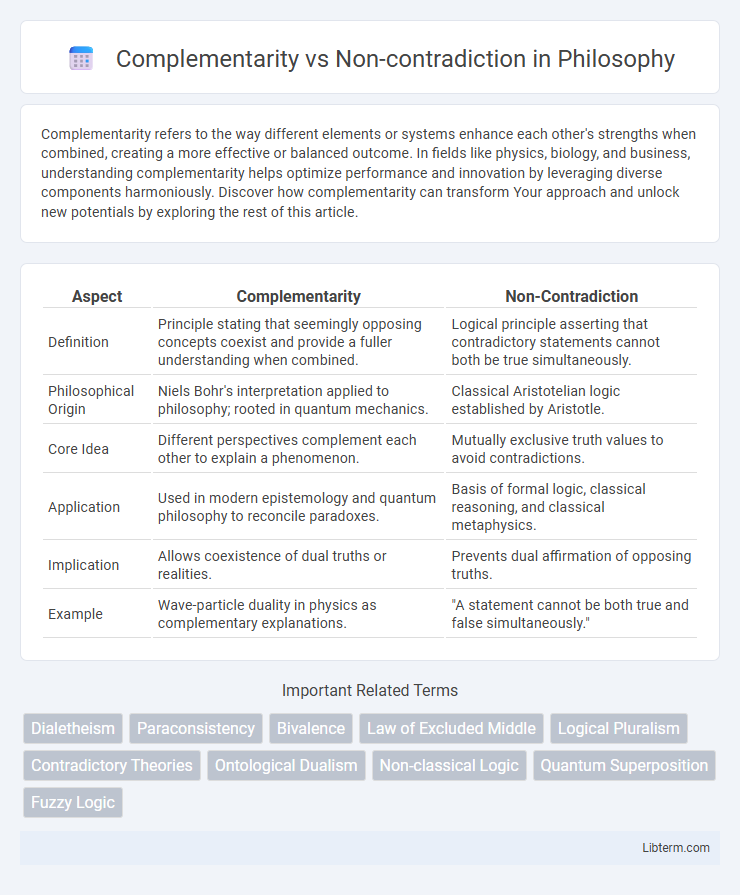Complementarity refers to the way different elements or systems enhance each other's strengths when combined, creating a more effective or balanced outcome. In fields like physics, biology, and business, understanding complementarity helps optimize performance and innovation by leveraging diverse components harmoniously. Discover how complementarity can transform Your approach and unlock new potentials by exploring the rest of this article.
Table of Comparison
| Aspect | Complementarity | Non-Contradiction |
|---|---|---|
| Definition | Principle stating that seemingly opposing concepts coexist and provide a fuller understanding when combined. | Logical principle asserting that contradictory statements cannot both be true simultaneously. |
| Philosophical Origin | Niels Bohr's interpretation applied to philosophy; rooted in quantum mechanics. | Classical Aristotelian logic established by Aristotle. |
| Core Idea | Different perspectives complement each other to explain a phenomenon. | Mutually exclusive truth values to avoid contradictions. |
| Application | Used in modern epistemology and quantum philosophy to reconcile paradoxes. | Basis of formal logic, classical reasoning, and classical metaphysics. |
| Implication | Allows coexistence of dual truths or realities. | Prevents dual affirmation of opposing truths. |
| Example | Wave-particle duality in physics as complementary explanations. | "A statement cannot be both true and false simultaneously." |
Understanding Complementarity: Key Concepts
Understanding complementarity involves recognizing that seemingly contradictory properties or phenomena can coexist and provide a fuller description when considered together, as seen in quantum mechanics with wave-particle duality. This key concept highlights how two different observations, such as position and momentum, cannot be precisely measured simultaneously but are both essential for a complete understanding of quantum systems. Unlike the principle of non-contradiction, which asserts that contradictory statements cannot be true at the same time, complementarity accepts the coexistence of dual perspectives that reveal different aspects of reality.
Defining Non-contradiction: Philosophical Foundations
Non-contradiction is a fundamental principle in classical logic and metaphysics stating that contradictory propositions cannot both be true simultaneously, such as "A is B" and "A is not B." Rooted in Aristotelian philosophy, this principle underpins rational discourse by ensuring consistency in truth claims and preventing logical paradoxes. Its philosophical foundation establishes clear boundaries for valid reasoning, distinguishing coherent arguments from contradictions that undermine knowledge.
Historical Origins of Complementarity and Non-contradiction
The principle of non-contradiction, rooted in Aristotelian logic around the 4th century BCE, asserts that contradictory statements cannot both be true simultaneously, forming the foundation of classical Western philosophy and reasoning. Complementarity emerged in the 20th century through Niels Bohr's interpretation of quantum mechanics, highlighting how particles exhibit dual properties like wave and particle aspects that are mutually exclusive yet collectively necessary for a complete understanding. These historical origins reflect a shift from absolute binary logic to embracing paradoxical dualities in scientific exploration.
Core Differences Between Complementarity and Non-contradiction
Complementarity recognizes that two seemingly contradictory properties or perspectives can coexist and provide a fuller understanding of a phenomenon, as seen in quantum mechanics with wave-particle duality. Non-contradiction is a classical logical principle stating that contradictory statements cannot both be true simultaneously in the same context. The core difference lies in complementarity allowing paradoxes as complementary truths, while non-contradiction demands absolute mutual exclusivity of opposing propositions.
Applications in Science: Quantum Physics and Classical Logic
Complementarity in quantum physics explains how particles exhibit wave and particle properties depending on the experimental setup, a principle essential for understanding phenomena like electron behavior and quantum superposition. Non-contradiction in classical logic dictates that contradictory statements cannot both be true simultaneously, forming the basis for consistent reasoning and proof systems. These concepts highlight the distinct frameworks of quantum mechanics and classical reasoning, where complementarity accommodates dual aspects of reality, while non-contradiction enforces clear binary truth values.
Complementarity in Multidisciplinary Contexts
Complementarity in multidisciplinary contexts refers to the integration of diverse perspectives and methods that address complex problems more effectively than any single discipline alone. This approach leverages the unique strengths and insights of each field to create a holistic understanding and innovative solutions. Emphasizing complementarity enhances collaboration, knowledge synthesis, and the ability to tackle multifaceted challenges in science, healthcare, and social sciences.
Non-contradiction in Formal and Informal Logic
Non-contradiction in formal logic serves as a foundational principle asserting that a statement and its negation cannot both be true simultaneously, ensuring consistency within logical systems. In informal logic, the principle guides everyday reasoning by preventing contradictory claims in argumentation, promoting clarity and coherence in discourse. The law of non-contradiction thus underpins both structured symbolic reasoning and practical argumentative evaluation by maintaining the integrity of truth assessments.
Integrating Both Principles in Problem Solving
Integrating complementarity and non-contradiction in problem solving enhances cognitive flexibility by recognizing that seemingly opposing perspectives can coexist without logical conflict. Employing the principle of complementarity allows simultaneous acceptance of dual aspects, while non-contradiction ensures clarity by preventing logical inconsistencies. This balanced approach fosters innovative solutions by combining holistic understanding with rigorous logical analysis.
Debates and Controversies: Limits and Strengths
Debates surrounding complementarity versus non-contradiction highlight limitations in rigid logical frameworks when addressing complex phenomena, especially in quantum mechanics and cognitive sciences. Complementarity offers strengths by allowing multiple, seemingly contradictory perspectives to coexist without negation, providing richer explanatory power than classical non-contradiction principles. Critics argue non-contradiction ensures clarity and consistency, but its inflexibility can hinder understanding nuances where dual aspects are essential for full comprehension.
Future Perspectives: Complementarity vs Non-contradiction
Future perspectives on complementarity versus non-contradiction emphasize the integration of both principles to enhance quantum mechanics interpretations and cognitive science models. Advances in quantum computing and artificial intelligence increasingly demonstrate scenarios where classical non-contradiction is insufficient, favoring a complementary framework that embraces dual truths and probabilistic states. This shift fosters novel approaches to problem-solving and knowledge representation, aligning logical systems with the complexities of emerging technological and scientific paradigms.
Complementarity Infographic

 libterm.com
libterm.com